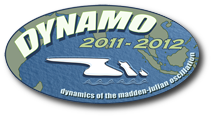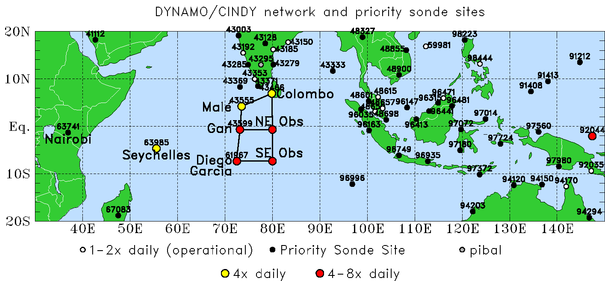HOME
LINKS
PRODUCTS
> SOUNDINGS
> GRIDDED
> ARRAY-AVG'S
> DROPSONDES
> QC PRODUCTS
> SATELLITE
> MAPS
> X-SECTIONS
 |
Dynamics of the Madden-Julian Oscillation Experiment CSU Mesoscale Dynamics Group |
 |
★ NOTE: ★
1) This website was primarily designed to be a useful tool during and shortly after the DYNAMO field campaign.
2) Most products on this website are preliminary and should be used with caution.
3) The latest versions of final products (sounding data, gridded datasets, and array averages) are now available at the website for the DYNAMO Legacy Data Project.
The DYNAMO field campaign is proposed as the US component of CINDY2011 (Cooperative Indian Ocean Experiment on Intraseasonal Variability in Year 2011), an international field program to be conducted October 2011 - March 2012 in the equatorial central Indian Ocean region. The overarching goal of DYNAMO is to expedite our understanding of processes key to MJO initiation over the Indian Ocean and our efforts to improve simulation and prediction of the MJO. DYNAMO consists of four integrated components: a field campaign, data analysis, modeling, and forecasting. This field campaign is designed to collect observations that are necessary to test hypotheses on three key aspects of MJO initiation: the structure and evolution of cloud populations, their interaction with the large-scale environment, and air-sea interaction. It will include an atmospheric sounding network (see the figure below), a radar network consisting of an island "supersite" with multiple radars (NCAR SPolKa, Texas A&M SMART-R C-band, DOE AMF2 X-, Ka- and W-bands) and shipborne C- and W-band Doppler radars, and a ship/mooring network to measure air-sea fluxes, marine atmospheric boundary-layer properties, and upper-ocean large-scale and mixing structures.

We gratefully acknowledge the support of the National Science Foundation:
- Grant No. AGS-1059899 (Physical & Dynamical Meteorology Section).
- Grant No. AGS-1138353 (Physical & Dynamical Meteorology and Climate & Large-Scale Dynamics Sections).
|
03 Jun 2020 22:33 MDT |
Dick Johnson johnson [at] atmos.colostate.edu 970-491-8321 |
Paul Ciesielski paulc [at] atmos.colostate.edu 970-491-8252 |
Rick Taft taft [at] atmos.colostate.edu 970-491-2347 |